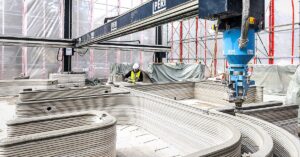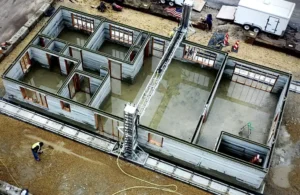3D printing, also known as additive manufacturing, has revolutionized various industries by providing efficient and cost-effective solutions to complex problems. The use of 3D printing technology in architecture and construction has become increasingly popular in recent years due to its ability to produce complex and intricate shapes with accuracy and speed. This article will explore the use of 3D printing in architecture and construction, its benefits, and limitations.
What is 3D Printing?
3D printing is a manufacturing process that creates three-dimensional objects from a digital file. The process involves building an object layer by layer, using a printer that extrudes materials such as plastic, metal, or concrete. The printer reads a digital file and deposits the material in a precise pattern, creating a solid object. This process enables architects and builders to create complex and intricate structures that were previously impossible to achieve.
The Use of 3D Printing in Architecture
The use of 3D printing in architecture has enabled architects to create complex designs and structures that were previously difficult or impossible to achieve. Architects can now use 3D printing technology to create models of their designs, allowing them to see how the finished structure will look and identify any potential issues before construction begins. This technology also allows architects to create complex designs with intricate details, which are difficult to achieve with traditional building methods.

One of the most significant benefits of 3D printing in architecture is its ability to create custom designs that meet specific requirements. Architects can use this technology to create unique structures that are tailored to the needs of their clients. This technology also allows architects to experiment with different designs and materials, enabling them to find the best solutions for their projects.
The Use of 3D Printing in Construction
3D printing is also being used in the construction industry to create building components such as walls, floors, and roofs. This technology allows builders to create these components off-site and then transport them to the construction site, reducing the time and cost of construction. 3D printing technology also enables builders to create complex shapes and designs that are difficult to achieve with traditional building methods.
One of the most significant benefits of 3D printing in construction is its ability to reduce waste. The construction industry is one of the largest producers of waste globally. However, 3D printing technology can significantly reduce waste by using only the necessary materials to create a structure. This technology also enables builders to recycle materials, reducing the impact on the environment.
Limitations of 3D Printing in Architecture and Construction
Despite the many benefits of 3D printing in architecture and construction, there are still some limitations to this technology. One of the main limitations is the size of the objects that can be printed. While 3D printing technology has advanced significantly in recent years, the size of the printer remains a limiting factor.
Another limitation is the cost of 3D printing technology. While the cost of 3D printers has reduced significantly in recent years, it is still an expensive investment for many architects and builders. Additionally, the cost of materials for 3D printing can also be high, particularly for larger structures.
Examples of 3D Printing in Architecture and Construction
There have been several notable examples of 3D printing in architecture and construction in recent years. One of the most famous examples is the 3D printed house in Nantes, France. This house was created using a 3D printer that extruded concrete layer by layer, resulting in a unique and intricate design that would have been impossible to achieve with traditional building methods.
Another example is the 3D printed bridge in Madrid, Spain. This bridge was created using 3D printing technology and is made entirely of steel. The bridge is a testament to the strength and durability of 3D printed structures and demonstrates the potential of this technology in the construction industry.
Benefits of 3D Printing in Architecture and Construction
The benefits of 3D printing in architecture and construction are numerous. One of the main benefits is the ability to create complex and intricate designs that would have been impossible to achieve with traditional building methods. This technology also enables architects and builders to create custom designs that meet the specific needs of their clients.
Another significant benefit is the reduction in waste and environmental impact. 3D printing technology can significantly reduce the amount of waste produced during the construction process by using only the necessary materials to create a structure. Additionally, this technology enables builders to recycle materials, reducing the impact on the environment.
3D printing technology also enables faster and more efficient construction. Builders can create building components off-site using 3D printing technology and then transport them to the construction site, reducing the time and cost of construction.
Future of 3D Printing in Architecture and Construction
The future of 3D printing in architecture and construction looks bright, with many exciting developments on the horizon. One of the most significant developments is the use of 3D printing technology to create entire buildings. While this technology is still in its early stages, several companies have already created 3D printed buildings, including a hotel in China and an office building in Dubai.

Another area of development is the use of 3D printing technology to create sustainable and environmentally friendly buildings. This technology enables builders to create structures using recycled materials and with minimal waste, reducing the impact on the environment.
3D printing technology also has the potential to reduce the cost of construction significantly. By creating building components off-site using 3D printing technology, builders can reduce the time and labor required on the construction site, resulting in significant cost savings.
Conclusion
The use of 3D printing technology in architecture and construction is an exciting development that has the potential to revolutionize these industries. This technology enables architects and builders to create complex and intricate structures that were previously impossible to achieve with traditional building methods. While there are some limitations to this technology, the benefits are significant, including the reduction in waste and environmental impact, the ability to create custom designs, and faster and more efficient construction. As 3D printing technology continues to advance, we can expect to see even more innovative uses in the field of architecture and construction in the future.






